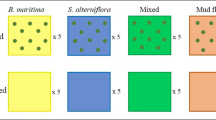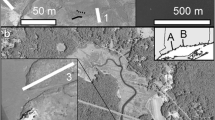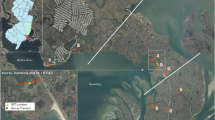Abstract
The services and functions provided by coastal wetlands are numerous and influenced by factors ranging from climate and tidal regime to ecosystem engineers and anthropogenic modifications. In New England salt marshes, fiddler crabs and purple marsh crabs are cooccurring species that are among the most conspicuous burrowing macroinvertebrates in the region. Both are known to influence salt marsh ecosystem functions through their burrowing and feeding behavior, but the ways in which they regulate specific properties, individually and together, is unclear. Using an ex situ mesocosm study, I manipulated the presence of fiddler crabs and purple marsh crabs in order to evaluate their impact on several soil properties and aboveground biomass. Results show that, contrary to previous studies, the fiddler crab had little impact while the purple marsh crab altered soil quality with positive implications for plant growth. This suggests that the purple marsh crab, known to be a voracious consumer of marsh vegetation, may play a much more nuanced role in the maintenance of plant growth than previously thought. Additional ex situ studies should be done to further delineate the impact of these two species.



Similar content being viewed by others
References
Altieri AH, Bertness MD, Coverdale TC, Herrmann NC, Angelini C (2012) A trophic cascade triggers collapse of a salt-marsh ecosystem with intensive recreational fishing. Ecology 93(6):1402–1410
Bates D, Maechler M, Bolker B, Walker S (2015) Fitting linear mixed-effects models using lme4. Journal of Statistical Software 67(1):1–48
Bertness MD (1985) Fiddler crab regulation of Spartina alterniflora production on a New England salt marsh. Ecology 66(3):1042–1055
Bertness MD (1992) The ecology of a New England salt marsh. American Scientist 80:260–268
Bertness MD, Brisson CP, Coverdale TC, Bevil MC, Crotty SM, Suglia ER (2014) Experimental predator removal causes rapid salt marsh die-off. Ecology Letters 17:830–835. https://doi.org/10.1111/ele.12287
Coverdale TC, Altieri AH, Bertness MD (2012) Belowground herbivory increases vulnerability of New England salt marshes to die-off. Ecology 93(9):2085–2094
Coverdale TC, Axelman EE, Brisson CP, Young EW, Altieri AH, Bertness MD (2013) New England salt marsh recovery: opportunistic colonization of an invasive species and its non-consumptive effects. PLoS ONE 8(8):e73823. https://doi.org/10.1371/journal.pone.0073823
Coverdale TC, Brisson CP, Young EW, Yin SF, Donnelly JP, Bertness MD (2014) Indirect human impacts reverse centuries of carbon sequestration and salt marsh accretion. PLoS ONE 9(3):e93296. https://doi.org/10.1371/journal.pone.0093296
Crane J (1975) Fiddler crabs of the world. Princeton University Press, Princeton
Daiber FC (1982) Animals of the tidal marsh. Van Nostrand Reinhold, New York
Deegan LA, Johnson DS, Warren RS, Peterson BJ, Fleeger JW, Fagherazzi S, Wollheim WM (2012) Coastal eutrophication as a driver of salt marsh loss. Nature 490:388–394. https://doi.org/10.1038/nature11533
Erwin KL (2009) Wetlands and global climate change: the role of wetland restoration in a changing world. Wetlands Ecology and Management 17:71–84
Gribsholt B, Kristensen E (2002) Effects of bioturbation and plant roots on salt marsh biogeochemistry: a mesocosm study. Marine Ecology Progress Series 241:71–87
He Q, Silliman BR (2016) Consumer control as a common driver of coastal vegetation worldwide. Ecological Monographs 86(3):278–294
Hedges LV, Gurevitch J, Curtis PS (1999) The meta-analysis of response ratios in experimental ecology. Ecology 8:1150–1156
Holdredge C, Bertness MD, Altieri AH (2009) Role of crab herbivory in die-off of New England salt marshes. Conservation Biology 23:672–679
Hothorn T, Bretz F, Westfall P (2008) Simultaneous inference in general parametric models. Biometrical Journal 50(3):346–363
Ives RL (1942) The beaver-meadow complex. Journal of Geomorphology 5:191–203
Jones CG, Lawton JH, Shachak M (1994) Organisms as ecosystem engineers. Oikos 69:373–386
Jones CG, Lawton JH, Shachak M (1997) Positive and negative effects of organisms as physical ecosystem engineers. Ecology 78:1946–1957
Kristensen R (2008) Mangrove crabs as ecosystem engineers; with emphasis on sediment processes. Journal of Sea Research 59:30–43
Kuznetsova A, Brockhoff P, Christensen R (2016) lmerTest package: tests in linear mixed effects models. Journal of Statistical Software 82(13):1–26. https://doi.org/10.18637/jss.v082.i13.
Lee SY (1997) Potential trophic importance of the faecal material of the mangrove sesarmine crab Sesarma messa. Marine Ecology Progress Series 159:275–284
Miller DC (1961) The feeding mechanism of fiddler crabs, with ecological consideration of feeding adaptations. Zoologica 46:89–101
Montague CL (1980) A natural history of temperate western Atlantic fiddler crabs with reference to their impact on salt marshes. Contributions in Marine Science 23:25–55
Moore AC (2018) Context-dependent consumer control in New England tidal wetlands. PLoS ONE 13(5):e0197170. https://doi.org/10.1371/journal.pone.0197170
Naiman RJ, Johnson CA, Kelley JC (1988) Alteration of north American streams by beaver. BioScience 38:753–762
Nelson D, Sommers L (1996) Total carbon, organic carbon, and organic matter. In Methods of soil analysis. Part 3. Chemical Methods (SSSA Book). Soil Science Society of America and American Society of Agronomy
Osenberg CW, Sarnelle O, Cooper SD (1997) Effect size in ecological experiments: the application of biological models in meta-analysis. The American Naturalist 150:798–812
Peer N, Miranda NAF, Perissinotto R (2015) A review of fiddler crabs (genus Uca leach, 1814) in South Africa. African Zoology 50(3):187–204
Qian P, Schoenau JJ (1996) Ion exchange resin membrane (IERM): a new approach for in situ measurement of nutrient availability in soil. Plant Nutrition and Fertilizer Sciences 2:322–330
Salo P, Banks PB, Dickman CR, Korpimaki E (2010) Predator manipulation experiments: impacts on populations of terrestrial vertebrate prey. Ecological Monographs 80(4):531–546
Smith NF, Wilcox C, Lessmann JM (2009) Fiddler crab burrowing affects growth and production of the white mangrove (Laguncularia racemosa) in a restored Florida coastal marsh. Marine Biology 156:2255–2266
Szillery JE, Fernandez IJ, Norton SA, Rustad LE, White AS (2006) Using ion-exchange resins to study soil response to experimental watershed acidification. Environmental Monitoring and Assessment 116:383–398
Teal JM (1958) Distribution of fiddler crabs in Georgia salt marshes. Ecology 39:185–193
Terwilliger J, Pastor J (1999) Small mammals, ectomycorrhizae, and conifer succession in beaver meadows. Oikos 85:83–94
Thongtham N, Kristensen E (2005) Carbon and nitrogen balance of leaf-eating sesarmid crabs (Neoepisesarma versicolor) offered different food sources. Estuaries and Coastal Shelf Science 65:213–222
Townsend I, Fletcher C, Knappen M, Rossington K (2011) A review of salt marsh dynamics. Water Environment Journal 25:477–488
Vu HD, Pennings SC (2018) Predators mediate above- vs. belowground herbivory in a salt marsh crab. Ecosphere 9(2):e02107. https://doi.org/10.1002/ecs2.210710.1002/ecs2.2107.
Wang JQ, Zhang XD, Jiang LF, Bertness MD, Fang CM, Chen JK, Hara T, Li B (2010) Bioturbation of burrowing crabs promotes sediment turnover and carbon and nitrogen movements in an estuarine salt marsh. Ecosystems 13:586–599
Wright JP, Jones CG, Flecker AS (2002) An ecosystem engineer, the beaver, increases species richness at the landscape scale. Oecologia 132:96–101
Zhang X, Jia X, Chen Y, Shao J, Wu X, Shang L, Li B (2013) Crabs mediate interactions between native and invasive salt marsh plants: a mesocosm study. PLoS ONE 8(9):e74095. https://doi.org/10.1371/journal.pone.0074095
Acknowledgements
I thank A. Andis, R. Buchkowski, M. Burak, and N. Moore for field assistance, O. Schmitz for advice on experimental design, R. Buchkowski and M. Lambert for guidance on statistical analyses, and M. Bradford, P. Raymond, and O. Schmitz for comments on the final manuscript. This research was supported through funding from the Yale Institute for Biospheric Studies (YIBS) and the Yale Natural Lands Fund.
Author information
Authors and Affiliations
Corresponding author
Additional information
Publisher’s Note
Springer Nature remains neutral with regard to jurisdictional claims in published maps and institutional affiliations.
Electronic supplementary material
ESM 1
(CSV 3 kb)
Rights and permissions
About this article
Cite this article
Moore, A. What Is the Role of Ecosystem Engineers in New England Salt Marshes? A Mesocosm Study of the Fiddler Crab and the Purple Marsh Crab. Wetlands 39, 371–379 (2019). https://doi.org/10.1007/s13157-019-01123-4
Received:
Accepted:
Published:
Issue Date:
DOI: https://doi.org/10.1007/s13157-019-01123-4




